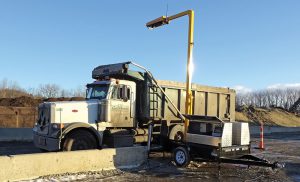Scanning technology calculates volumes of inbound and outbound loads, accounting for variability in raw feedstocks and finished products.
Craig Coker
BioCycle January 2016

An open-top truck containing materials passes under a load volume scanner, which maps a 3-D image of the load. Photo courtesy of LoadScan
Organics recycling facilities, particularly those in the composting industry, are all about materials handling. Feedstocks coming into a site, materials moving around a site, and products going out to market are hallmarks of most composting facilities. A universal challenge at these operations is managing these materials with different measuring sticks. Incoming feedstocks are paying a tipping fee on a per-ton or on a unit volume basis, quantities of materials moving through the production process are usually measured in volumes, and outgoing compost and soil products are often sold on a volume basis.
Many composters have learned how to measure the bulk densities of various materials in their production systems and use that measure of volume per unit weight to convert back and forth between weights and volumes. However, bulk densities of materials are heavily influenced by moisture content, so outdoor facilities can have very different bulk densities in a pile before and after rainfall events. Also, measuring bulk density is a snapshot in time as the density of compost piles increase as they age.
These measurement uncertainties can have significant financial performance impact. The actual volumes of product loaded into a truck going to market can vary with how the loader operator picks up material and how it is dropped into a truck. The sales invoice could indicate 40 cubic yards (cy) was shipped, but maybe it was only 38 cy or as much as 42 cy. The composter has either an unhappy customer or is losing money on the load. Another risk is that loading wet, heavy materials could result in a truck being overweight on the roads and subject to fines. Similarly, if a composter buys 1,000 truckloads of wood chips in a year, expecting 20 cy on every truck but is only getting 19 cy, that facility is paying for 1,000 cy of wood chips it is not receiving.
Load Volume Scanning
Load volume scanning (LVS) is a technology that addresses these materials handling challenges. LVS evolved in the 1990s for the aggregates and construction industries from three-dimensional laser object scanning in the engineering and surveying industries. Essentially, an open-top truck containing materials passes under the scanner, which maps a 3-D image of the load in the trailer. A radio-frequency identification tag (RFID) mounted on the trailer identifies the trailer for comparison to a previous scan of the trailer when empty. The difference in volumes (full vs. empty) is calculated by a computer and a volume ticket is printed indicating the volume of that particular load. If the empty truck scan is not in the database, the delivery truck is scanned after unloading or before loading to get that “tare volume” into the database.
New Earth is a Texas-based compost, soils and mulch producer with three facilities handling about 500,000 tons/year of incoming materials. It has been using a LVS technology from a New Zealand company, LoadScan, since 2010 at its San Antonio facility. (It’s also now used at the two other locations.) New Earth uses the system to scan both incoming and outgoing material on any open-top truck. Closed trucks (like the food waste delivered by the City of San Antonio) are still weighed by scales at the front of the plant.
“We estimate the return on investment at San Antonio to be less than 12 months,” notes Clayton Leonard, owner of New Earth, “as LVS has allowed us to improve our Cost of Goods Sold by driving our purchasing decisions to more cost-effective suppliers.” For example, he explains, New Earth buys sand for soil blends and most sand sources charge a fixed price per load. By scanning incoming loads of sand from several sources, he can identify which suppliers are sending the driest material so New Earth doesn’t have to pay for water. The data from the LoadScan system also gives Leonard the opportunity to “true up” production costs. “The scanners show us exactly how much material has gone into a blend and exactly what the end product volume is, allowing us to accurately determine both cost and end price,” adds Leonard.
The LoadScan system is set up on a 100-foot by 12-foot concrete slab with a smooth surface (so as not to give false information to the scanner). There are two scanners, one lateral and one running length-wise. The system needs a single-phase power feed and a communications cable. “We clean the lenses on the scanners every month or so to remove dust,” he notes, “ and on a cold day with a warm load, the steam can fog up the lenses so we have to wait a few minutes for the lenses to clear.” He adds the operation and maintenance cost on the LoadScan system has been essentially zero.
The measurement system is also a tool in New Earth’s sales toolbox for customers. Leonard can give larger volume customers a daily report which includes the number of trucks leaving New Earth, the volume of material on each truck, the time the truck departed and a running total for the day. “Once we educate our customers on the value of the information they get from the LVS system, they appreciate our commitment to precision and information quality,” he says. “Information is power. We can guarantee customer supply quantities which has put a stop to all uncertainty.”
Craig Coker is a Senior Editor at BioCycle. He can be reached at ccoker@jgpress.com.














